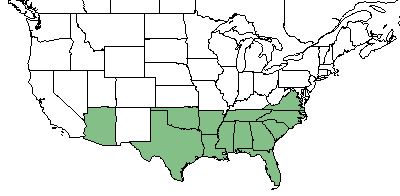Sporobolus junceus
| Sporobolus junceus | |
|---|---|

| |
| Photo by James H. Miller, USDA Forest Service, Bugwood.org hosted at Forestryimages.org | |
| Scientific classification | |
| Kingdom: | Plantae |
| Division: | Magnoliophyta - Flowering plants |
| Class: | Liliopsida - Moncots |
| Order: | Poales |
| Family: | Cyperaceae |
| Genus: | Sporobolus |
| Species: | S. junceus |
| Binomial name | |
| Sporobolus junceus (P. Beauv.) Kunth | |

| |
| Natural range of Sporobolus junceus from USDA NRCS Plants Database. | |
Common name(s): sandhills dropseed,[1] pineywoods dropseed[2]
Contents
Taxonomic Notes
Description
Sporobolus junceus is a monoecious perennial graminoid.[2]
Distribution
This species is found in southeastern Virginia, south to Florida and westward to southeastern Oklahoma and Texas.[1]
Ecology
Habitat
S. junceus is found in sandhill and other dry open areas[1], where it can become one of the more dominant grasses.[3] It appears to be rather shade tolerant since its coverage is not correlated with longleaf pine stand density.[4]
Phenology
This species generally flowers from September through November, peaking in October,[1][5], although there are reports of flowering occurring between March and June as well.[5]
Fire ecology
Burns during April, May, and July yielded larger numbers of flowers than burns at other times of the year in a Florida sandhill longleaf pine community.[3][6] After a May burn in north Florida, inflorescence and mature seeds were produced within 7-9 weeks following the fire.[6] Despite affecting flowering and seeds, an Alabama study in 2004 and 2005 showed no difference in stem densities between burned and unburned glades. These densities ranged from 1.5 to 3.4 stems m-2.[7]
Use by animals
S. junceus provides 2-5% of the diet of some terrestrial birds.[2]
Conservation and Management
Cultivation and restoration
On a central Florida sandhill, S. junceus planted in the winter established very well on overburned soils and produced the highest densities (up to 10 plants m-1 of the plants tested.[8] Seeds can be hand collected and mixed with others (e.g. wiregrass) for sowing on restoration sites.[9]
Photo Gallery
References and notes
- ↑ 1.0 1.1 1.2 1.3 1.4 Weakley A. S.(2015). Flora of the Southern and Mid-Atlantic States. Chapel Hill, NC: University of North Carolina Herbarium.
- ↑ 2.0 2.1 2.2 2.3 USDA, NRCS. (2016). The PLANTS Database (http://plants.usda.gov, 8 January 2018). National Plant Data Team, Greensboro, NC 27401-4901 USA.
- ↑ 3.0 3.1 Shepherd B. J., Miller D. L., and Thetford M. (2012). Fire season effects on flowering characteristics and germination of longleaf pine (Pinus palustris) savanna grasses. Restoration Ecology 20(2):268-276.
- ↑ Harrington T. B. (2006). Plant competition, facilitation, and other overstorey-understory interactions in longleaf pine ecosystems. In: Jose S., Jokela E. J., and Miller D. L. (eds) The longleaf pine ecosystem: ecology, silviculture, and restoration. Springer, New York, pp. 135-156.
- ↑ 5.0 5.1 Nelson G. (8 January 2018) PanFlora. Retrieved from gilnelson.com/PanFlora/
- ↑ 6.0 6.1 Canfield S. L. and Tanner G. W. (1997). Observations of pineywoods dropseed (Sporobolus junceus) phenological development following fire in a sandhill community. Florida Scientist 60(2):69-72
- ↑ Duncan R. S., Anderson C. B., Sellers H. N., Robbins E. E. (2008). The effect of fire reintroduction on endemic and rare plants of a southeastern glade ecosystem. Restoration Ecology 16(1):39-49.
- ↑ Pfaff S., Maura, Jr. C., and Gonter M. A. (2001). Performance of selected Florida native species on reclaimed phosphate minelands. #96-03-120R Brooksville, FL.
- ↑ Brockway D. G., Outcalt K. W., Tomczak D. J., and Johnson E. E. (2005) Restoration of Longleaf Pine Ecosystems. United States Department of Agriculture, Forest Service, Southern Research Station, General Technical Report SRS-83.